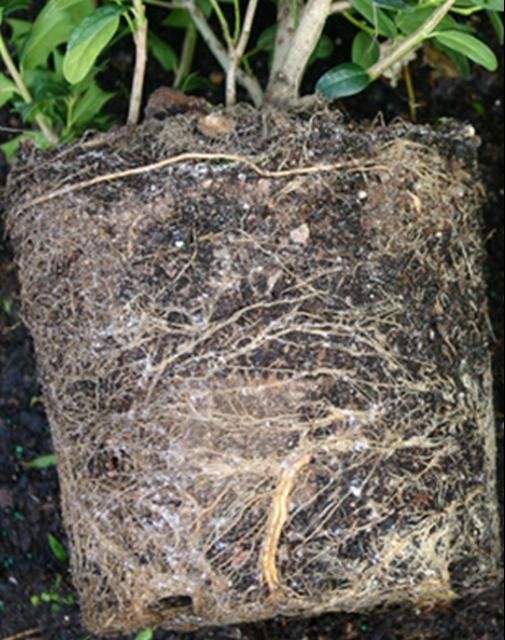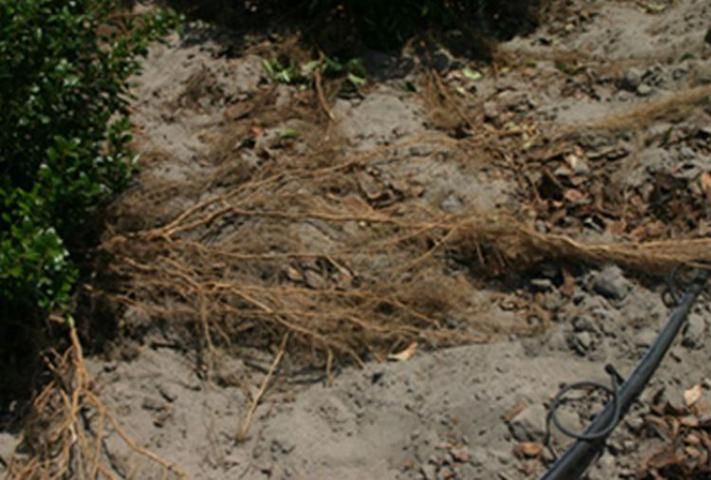Introduction
Plants in their native habitat grow from seeds and slowly adapt to their surroundings. As roots spread out and down into the soil, the roots adjust to soil properties (depth and drainage) of the site. Adapted plants survive while those that are not able to adapt grow poorly and die. This natural process takes place routinely in the forest.
Shrubs planted in the landscapes are usually purchased from a nursery, where they are grown in a container. Instead of the roots spreading out naturally, roots of container-grown plants grow around and down the sides of the container, resulting in an artificially dense root system (Figure 1).

Credit: Edward F. Gilman, UF/IFAS
Additionally, irrigation is applied daily (sometimes several times daily) in the nursery to keep the container-grown plants healthy. To maintain this same health status once planted in a landscape, shrubs would require daily irrigation until their roots grew into the surrounding soil. However, few shrubs receive this treatment in the landscape because it is not practical in most situations.
Several months are required for a shrub planted from a 3-gallon nursery container to adjust to its new landscape surroundings. Specifically, roots must grow from the artificial confines of the container into the surrounding landscape soil. Roots grow in response to soil conditions at the site and over time spread out and sometimes down into a more natural position (Figure 2). This root growth and redistribution takes about 6 to 12 months in most parts of Florida. To keep shrubs reasonably healthy during this period of adjustment (called the establishment period), irrigation is required. Irrigating newly planted shrubs for only one or two months could result in stressed plants and plant death unless regular rainfall follows. Once shrubs are established, however, they should survive on rainfall alone unless they are planted in a situation that increases their irrigation needs (Table 1).

Credit: Edward F. Gilman, UF/IFAS
Establishing Shrubs in the Landscape
- Consider planting at the beginning of the rainy season.
Shrubs can be established during any season in Florida. However, local seasonal fluctuations in temperature, rainfall, and other environmental conditions will influence shrub establishment. Planting under hot, sunny, dry conditions, typical of the spring and fall seasons in Florida, may reduce shrub vigor and slow establishment unless regular irrigation occurs.
- Plan to irrigate based on location in Florida, weather, and desired plant vigor.
Shrubs planted from 3-gallon containers can be established in the northern half of Florida–north of Orlando–with as little as one gallon of irrigation water applied every eight days. In the southern half of the state–south of Orlando, apply a gallon of water every four days (Table 2). More frequent irrigation (e.g., every four days in north Florida and every two days in south Florida) has been shown to result in more vigorous plant growth. However, applying a volume greater than one gallon per irrigation event does not increase survival or growth. Light, frequent applications are much more efficient and effective than applying large volumes less frequently. Applying large volumes of water cannot compensate for infrequent irrigation.
- Apply water directly to the rootball.
All shrub roots are confined to the rootball during the first few weeks after planting. Therefore, irrigation should be applied directly to the top of the rootball and to the several inches of soil surrounding the rootball.
- Use low-volume irrigation.
Irrigation should be delivered using a hose or low–volume irrigation device (Table 3).
Low-volume irrigation devices—such as drippers, bubblers or spray-stakes—efficiently apply water to the soil and establishing plants. Applying overhead irrigation over the entire planting bed wastes water and money since most of the water is applied to the soil between the rootballs. There are few roots in this area in the first couple of months after planting. Additionally, some water applied with overhead sprinklers never makes it to the root system because the water is intercepted by the plant canopy.
Using the minimum amount of water required and applying it appropriately will save water and reduce expense over the long-term. Irrigation guidelines, below, are based on research conducted at the University of Florida for typical 3-gallon (#3) container grown shrubs (Table 2). Plants from smaller containers require irrigation for a shorter period, whereas plants in larger containers typically take longer to establish.
- Avoid watering between 10 a.m. and 4 p.m.
A significant amount of irrigation will be lost to evaporation when watering with overhead irrigation during the heat of the day. Check with your municipality and water management district for the latest watering restrictions.
- Install a rain gauge in your yard.
A rain gauge allows you to measure rainfall. This is a simple method of tracking how much natural rainfall occurred since the last time the gauge was emptied.
- Don't irrigate if ¼ inch or more rainfall occurred in the previous 24 hours.
Irrigation should not be applied just after a rain event because this wastes water.
- Monitor the irrigation system for leaks or programming errors.
Water may be leaking from broken connections, pipes, or valves in the system. The water meter or utility invoice should be checked regularly for unusually high-water usage.
- Discontinue regular irrigation after shrubs are established.
Shrubs are considered established when they can survive and grow without irrigation. Most shrubs can make it on rainfall alone once roots have grown to the edge of the foliage canopy. This root growth normally occurs within 20–28 weeks after planting if the guidelines provided here are followed and normal rainfall occurs.
- Irrigate after establishment when there are signs of wilting, but before leaves begin to die.
In prolonged hot, dry weather, occasional irrigation may be needed after the establishment period. Such weather can occur at any time in Florida but is most likely to occur in the spring and fall—April, May, October and/or November. During the first year after planting, 1–2 gallons of water may be needed during periods of more than approximately two weeks without a ¼ inch of rain. Drought-sensitive shrubs—such as holly fern and wild coffee—may need more frequent supplemental irrigation, whereas, drought-tolerant shrubs, such as Burford holly, may need very little.
Summary
Regular irrigation in the months following planting ensures that shrubs remain healthy and attractive as they establish. Shrubs can survive and grow with little or no irrigation once roots grow to the outer edge of the canopy. This root growth typically requires about 20 to 28 weeks after planting in most of parts of Florida when normal rainfall occurs. Supplemental irrigation may be needed when rainfall is below normal in the first year after planting.
Pertinent Literature and Additional Reading
Haley, M.B., M.D. Dukes, and G.L. Miller. 2007. Residential irrigation water use in central Florida. J. Irrigation and Drainage Engineering. 133:427–434.
Haman, D.Z., M.D. Dukes, and S.G. Park-Brown. 2002. Retrofitting a traditional in-ground sprinkler irrigation system for microirrigation of landscape plants. ABE324. Gainesville: University of Florida Institute of Food and Agricultural Sciences. https://ufdc.ufl.edu/IR00001528/00001
Gilman, E.F., C. L. Wiese, M. Paz, A. L. Shober, S.M. Scheiber, K.A. Moore, and M.M. Brennan. 2009. Effects of Irrigation Volume and Frequency on Shrub Establishment in the Landscape. J Environ. Hort. 27(3):149-154
Moore, K.A., A.L. Shober, E.F. Gilman, C. Wiese, M.Paz, M.M. Brennan. 2009. Growth of wild coffee, copperleaf, orange jasmine is affected by irrigation frequency. HortTechnology 19(4):786-791.
Salamone, D. 2002. A drying oasis series: Florida water crisis chapter 1. Orlando Sentinel. 03 Mar: A1.
Scheiber, S.M., E.F. Gilman, M.Paz, and K.A. Moore. 2007. Irrigation affects landscape establishment of Burford holly, pittosporum, and sweet viburnum. HortScience. 42:344–348.
Scheiber, S.M, E.F. Gilman, D.R. Sandrock, M. Paz, C, Wiese, and M.M. Brennan. 2008. Postestablishment landscape performance of Florida native and exotic shrubs under irrigated and non-irrigated conditions. HortTechnology 18:59–67.
Shober, A.L., K.A. Moore, C. Wiese, S.M. Scheiber, E.F. Gilman, M. Paz, and M.M. Brennan. 2009. Irrigation frequency affects the growth of sweet viburnum during landscape establishment. HortScience 44(6):1683-1687.
Thayer, R.L. 1982. Public response to water-conserving landscapes. HortScience. 17:562–565.
Wiese, C., E.F. Gilman, M. Paz, A.L. Shober, K.A. Moore, S.M. Scheiber, M.M. Brennan, S. Vyapari. 2009. Effects of irrigation frequency during establishment on the growth of Ilex cornuta 'Burfordii Nana' and Pittosporum tobira 'Variegata'. HortScience44(5):1438-1443
Additional Resources
Planting Shrubs and Conserving Water—https://hort.ifas.ufl.edu/irrigation/
Irrigation Research Website—https://abe.ufl.edu/faculty/mdukes/
Landscape Plants—https://hort.ifas.ufl.edu/woody/
This publication is the result of research that was funded by the following agencies:
Florida Department of Agriculture and Consumer Services
St. Johns River Water Management District
Southwest Florida Water Management District
South Florida Water Management District
Table 1. Situations that Can Increase Irrigation Needs after Shrubs Are Established.
Table 2. Irrigation Schedule for Establishing Shrubs in Well Drained Soil (This schedule is based on shrubs planted from 3-gallon, smooth-side, plastic containers).
Table 3. Low Volume Irrigation Emitter Types and Application Times Required to Deliver One Gallon of Water (No more than one gallon is required at each application).